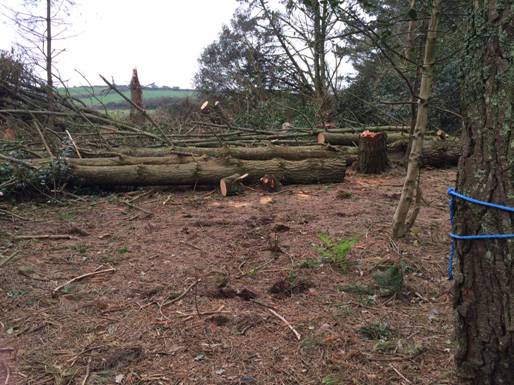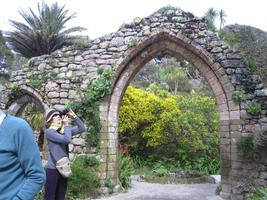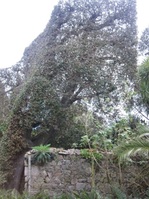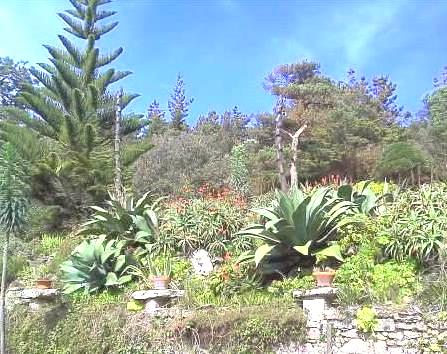Cornwall and Tresco, April 2014
Charles and Jennie Smith write… We were 16 in all, when 14 intrepid souls took up our offer to visit eight gardens in West Cornwall over three days, plus a day for Tresco on the Scilly Isles. We used the Yellow Book to establish our short list and narrowed our choice further to restrict driving times on the narrow Cornish lanes; we had seen all except Tresco on our preparatory tour in 2013. Six of the gardens were on the Lizard plus two near Penzance. The Tresco journey was horribly complicated and gave us sleepless nights but, when the time came we were lucky with the weather. We found the experience, our first as garden tour leaders, very challenging but ultimately rewarding.
In general Cornish soils are acid, granite everywhere, the winters mild and the rains frequent. To these features 2014 added long periods of extreme wind, wreaking garden havoc.


Group and Richard Morton, Head Gardener
Trewidden, Buryas Bridge, Penzance
The creation of Trewidden dates back to the 19th century; it has remained in the hands of the Bolitho family (one of the great gardening dynasties of Cornwall, including Caerhays) to the present day. Its 15 acres have been managed for the last seven years by Richard Morton (ex Kew). He’s a self-confessed plant nerd with a passion for his champion trees, for example Magnolia x veitchii, 80ft high with an 80ft flower-covered canopy. Trewidden is on a sloping site with magnolias, camellias, rhododrendons and a former open-cast tin mine filled with tree ferns.






The house is large whilst appearing modest. In a pastiche of styles it looks out over a vast acreage formerly in its sole ownership. It is a perfect example of a Victorian plantsman’s Cornish garden lovingly maintained through high levels of gardening skill for over 160 years. Trewidden and Tremenheere are only a few miles apart but have very little in common and provide a stimulating contrast.

No house, just a very beautiful café and 16 acres of absolute wonder. In the lower area ponds and a stream provide contemplative space amidst temperate forest (southern hemisphere predominating). Above is a steep terraced bank with views to St Michael’s Mount and hot climate plants: cycads, restios, grass trees, bamboos, echiums, palms, cacti and succulents. Neil’s aim has been to create a garden with year-round interest which, not having the focus of a house, has enabled a different vision to be followed. Nor does the sculpture element follow the path of others but instead offers fascinating buildings, some by the American artist James Turrell. We were taken around by Andy Gavin and plundered his extensive knowledge; we were privileged to have Neil talk informally over tea giving us his history and the inception, creation and expansion of his unique garden.
Trewidden and Tremenheere are members of Great Gardens of Cornwall. They have regular public openings. Better weather greeted us as we embarked on visits to three gardens and an excellent pub lunch at the Halzephron Inn, Gunwalloe.
The Garten Garden
Dr Sara Gadd is a garden designer with a background in art and design. Inspired by her love of plants and people, she explained how the process of designing gardens evolves with her clients and she illustrated her talk with examples of her working practice. Sara’s own charming garden is full of unusual design ideas and solutions, informed by her commitment to beauty, ecology, wildlife and practicality.
To learn more about her approach, go to Sara’s websitehere.
Carminowe Valley Garden
Marion and Peter Stanley are creating an extensive garden beneath their cottage on a 3.5 acre plot just inland from the sea and dissected by the River Carminowe. Marion’s love of colour is evident as is her passion for roses and heucheras. Below the formal planting is a charming streamside woodland garden with walkways through the natural planting. The garden is open via the NGS – click here for more information.
Bonython Manor
In contrast to the other two gardens, this remarkable creation is laid out over 20 acres and features in Great Gardens of Cornwall to which there is a link here. Its creator is Sue Nathan who left her native South Africa with her husband and has been continually developing and enlarging this superb garden for 14 years. Around the Georgian house the planting is formal but the design innovative and unusual. A large walled garden featuring a herbaceous border and an orchard with Cornish varieties of apple trees leads down to three lakes accessed through woodland planting of great exuberance.
A silver birch arboretum surrounds a mowed mound topped by an arresting sculpture. Sue gave us two hours of her time followed by excellent and timely refreshments.



Abbey Gardens of Tresco, Isles of Scilly
It was an impressive finale to the few days we had spent visiting mainland Cornish gardens, to board a small plane and hurtle off the cliff at Lands End heading for the Isles of Scilly, the magic islands of the west, lying fully in the Gulf Stream, 30 miles out into the Atlantic. From the ferry launch crossing to the island of Tresco the high trees of the Abbey Gardens were prominent on the low island generally covered in heather and scrub. The trees form a shelter belt to protect the garden from the salt-laden gales which blow in from the Atlantic, and these have been developed over 180 years starting with the first windbreaks of the stone walls of the ruined Abbey and gorse bushes, to the present 30 foot high (recently reduced from 45 feet) clipped evergreen hedges (Quercus ilex) and tall trees.

Remains of 10C Abbey


Quercus ilex hedges
Some Tresco facts:
- 20,000 plants from 80 different countries can be found in the 17 acre garden.
- At the mid-winter solstice 300 flowering plants have been counted.
- The range of average temperature in the garden over the year is 8 degrees C.
- Gale force wind can blow on average on 24 days of the year.
- The exceptions: – In 1989 snow fell, in 1987 there was a hurricane, last winter wind speeds reached 100 mph. In 1926 gales blew for five days and destroyed 600 trees.
Tresco Website
Below are a few photos which may just give a hint of the exuberant and fascinating plants from wide-ranging regions, closely jostling each other with extraordinary bio-diversity along the terrace paths. here

























